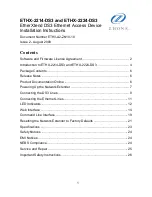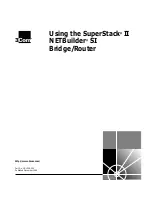
36
AT-AR256E v3 - 4 Ports ADSL2/2+ Router - User Manual
Quality of Service
Quality of Service allows network administrators to configure the routers to meet the real time
requirements for voice and video.
Different networks use different QoS markings like:
•
ToS network: ToS bits in the IP header
•
VLAN network: priority bits in the VLAN header
•
DSCP network: uses only 5 bits of the CoS
•
WLAN: WLAN QoS header.
The QoS framework is supported on all the above domains. How do you make them talk to each other?
How can you make sure the priority from one network is carried over to another network? Class of service
(CoS) is introduced as the common language for the QoS mappings. When QoS is enabled, the router has
full control over packets from the time they enter the router till they leave the router. This is how it works:
The domain mapping (ToS bits, priority bits, etc.) of a packet needs to be translated to CoS when the packet
enter the router and vice versa, the CoS of a packet needs to be translated back to the domain mapping
when the packet leaves the router.
There are 6 types of CoS (in descending priority):
•
CoS1
•
CoS2
•
CoS3
•
CoS4
•
CoS5
•
CoS6
The rules are:
1.
CoS1 has absolute priority and is used for Expedited Forwarding (EF) traffic. This is always serviced till
completion.
2.
CoS2-CoS5 is used for Assured Forwarding (AF) classes. They are serviced in a strict round robin
manner using the following priority scheme:
CoS2 > CoS3 > CoS4 > CoS5
3.
CoS6 is for Best Effort (BE) traffic. This is only serviced when there is no other class of service. If QoS
is not enabled on your router, all traffic will be treated as best effort.
There are some additional terms you should get familiarize with:
•
Ingress: Packets arriving into the router from a WAN/LAN interface.
•
Egress: Packets sent from the router to a WAN/LAN interface.
•
Trusted mode: Honors the domain mapping (ToS byte, WME, WLAN user priority).
•
Untrusted mode: Does not honor domain mapping. This is the default QoS setting.
•
Traffic Conditioning Agreement (TCA): The TCA needs to be defined for each interface:
Ingress mappings (Domain =>CoS)
Egress Mappings (CoS => Domain)
Untrusted mode (default)
•
Shaper
Egress
For packets going out of the router, the markings (CoS) need to be translated to the mappings understood
by the network domains. The reverse CoS and domain mapping is configured using the Egress. To access
Egress
, select the
Advanced
menu
then select
QoS > Egress
.
There are three Egress modes:
•
No Egress mode
•
Layer 2
•
Layer 3
















































